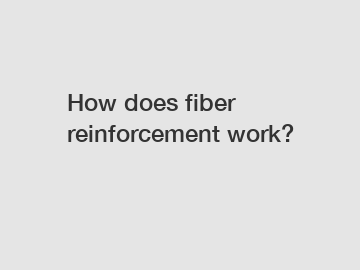How does fiber reinforcement work?
Fiber reinforcement is a crucial component of many construction materials and products. From reinforced concrete to composite materials, fiber reinforcement plays a key role in enhancing the strength and durability of these materials. But how exactly does fiber reinforcement work? In this blog post, we will delve into the science behind fiber reinforcement and explore its benefits and applications.
Fibers used for reinforcement can be made from a variety of materials, including glass, carbon, aramid, and natural fibers like bamboo and jute. These fibers are typically added to a matrix material, such as concrete, plastic, or metal, to improve its mechanical properties. The fibers work in tandem with the matrix material to provide enhanced strength, toughness, and resistance to cracking and deformation.
One of the key mechanisms by which fiber reinforcement works is through the principle of crack arrest. When a material is subjected to stress, tiny cracks may form within the matrix. These cracks can propagate and lead to failure of the material. However, when fibers are present in the matrix, they can act as barriers to crack propagation. The fibers absorb some of the energy from the stress and prevent the cracks from spreading, thus increasing the material's resistance to failure.

Additionally, fibers can also improve the tensile strength of a material. Most traditional construction materials, such as concrete, are strong in compression but weak in tension. By adding fibers to the matrix, the material becomes more resistant to tensile forces. The fibers effectively bridge the gaps between particles in the matrix, distributing the load more evenly and preventing the material from cracking under tension.
Furthermore, fiber reinforcement can enhance the ductility of a material. Ductility refers to the ability of a material to deform without breaking. By adding fibers to the matrix, the material becomes more flexible and less prone to brittle failure. This is particularly important in applications where the material is subjected to dynamic or impact loads, as the fibers can help absorb and dissipate energy, reducing the risk of catastrophic failure.
Additional reading:Revolutionizing Corners: The Game-Changing Mud Technique?
Innovative DIY Techniques for Repairing Curved Drywall?
Inside Tuoxin's Self-Adhesive Drywall Joint Tape Factory
Ultimate Guide to High Temp Fiberglass Mesh
Why choose Tuoxin high quality fiberglass mesh?
Ultimate Guide to Drywall Tape Types: Which is Best for Your Project?
How to Choose Drywall Taping Inside Corners?
In addition to improving mechanical properties, fiber reinforcement can also enhance the durability and longevity of a material. For example, in reinforced concrete, fibers can help reduce the formation of cracks due to shrinkage or temperature fluctuations. This can significantly extend the lifespan of the structure and reduce maintenance costs over time.
There are several methods for incorporating fibers into a material. In the case of concrete, fibers can be added during the mixing process or applied as precast reinforced elements. The type, length, and orientation of the fibers can be adjusted based on the specific requirements of the application. For example, long and continuous fibers are often used in applications requiring high tensile strength, while short and randomly oriented fibers are used for improving impact resistance.
Fiber reinforcement is widely used in various industries, including construction, aerospace, automotive, and marine. In the construction industry, fiber-reinforced concrete is commonly used for roads, bridges, buildings, and other structures that require high strength and durability. In the aerospace and automotive industries, composite materials reinforced with carbon or glass fibers are used to make lightweight yet strong components for aircraft, cars, and other vehicles. In the marine industry, fiber-reinforced plastics are used for boat hulls, decks, and other components that require resistance to water and corrosion.
In conclusion, fiber reinforcement is a versatile and effective technique for improving the mechanical properties of materials. By adding fibers to a matrix material, engineers can enhance its strength, toughness, and durability, making it suitable for a wide range of applications. Whether it's building a skyscraper, manufacturing a high-performance vehicle, or constructing a durable boat, fiber reinforcement plays a crucial role in ensuring the structural integrity and longevity of the final product.
If you are looking for more details, kindly visit mesh tape vs paper tape drywall, is mesh drywall tape better than paper, repair drywall corners.
Additional reading:How to master the art of cornering?
What is Fiberglass? A Manufacturer's Guide To Types ...
Revolutionary Ways to Transform Drywall Corners?
The Benefits of Using How to Repair Corner Bead on Drywall
4 Tips for Choosing How to Mud Drywall with Mesh Tape
Ultimate Guide to Using Paper Drywall Tape
How Does waterproof mascara Work?
Previous: What is the purpose of fiberglass mesh?
Next: Can Fiberglass Mesh Drywall Tape Be Used for Ceiling Repairs?
Related Articles
If you are interested in sending in a Guest Blogger Submission,welcome to write for us!












Comments
0